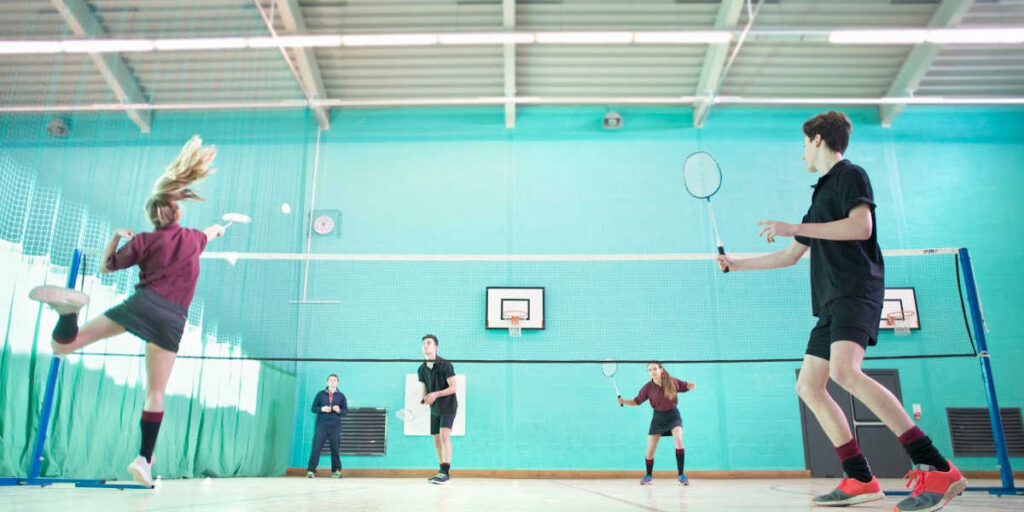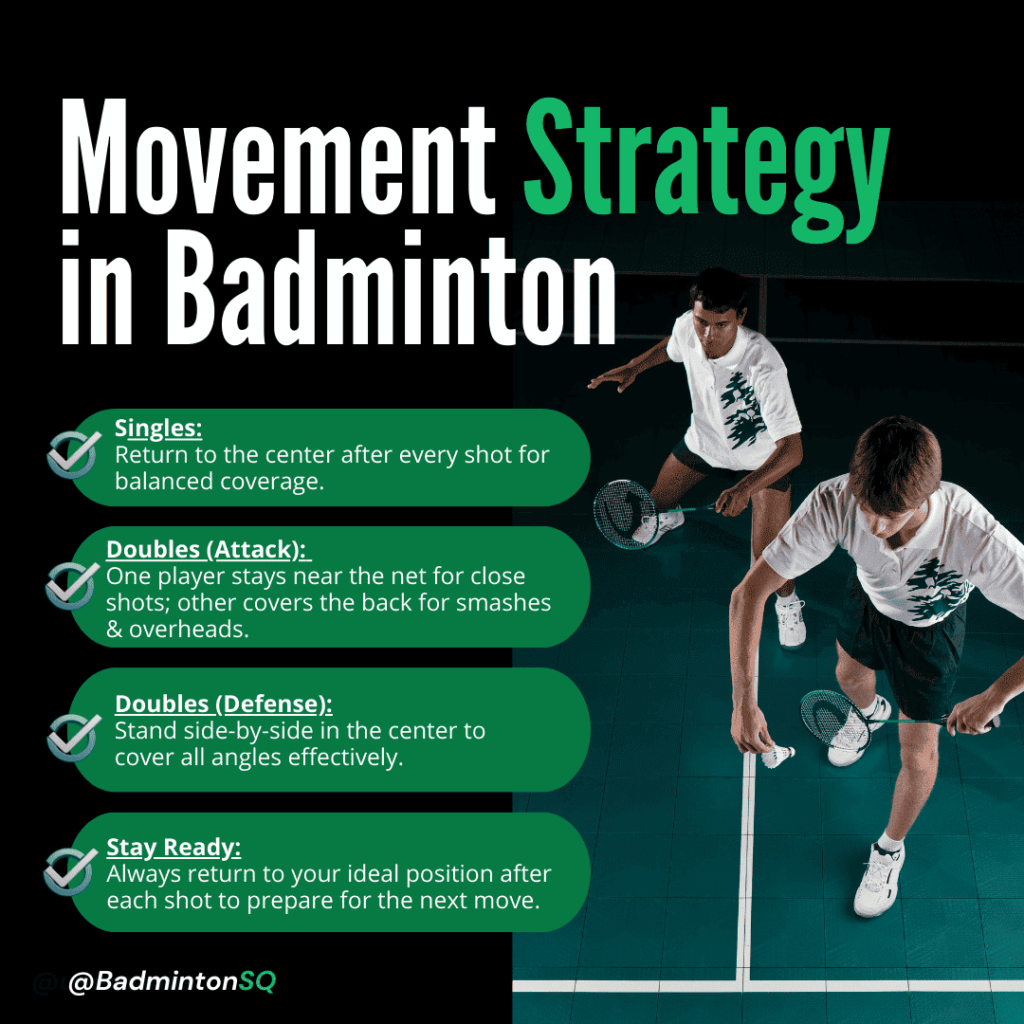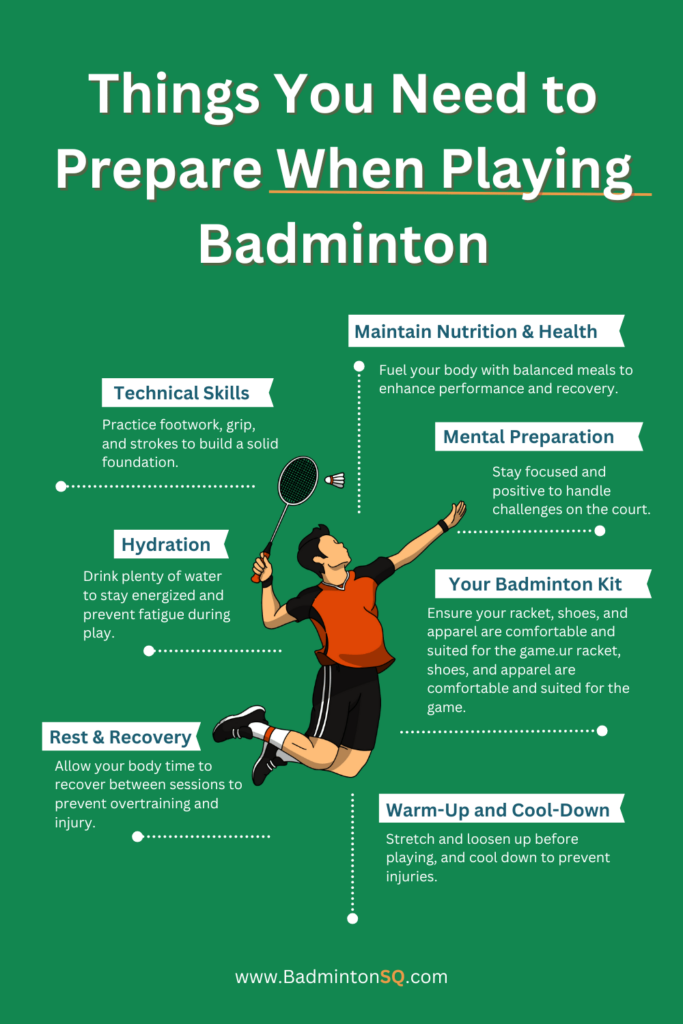Badminton majorly has two categories – singles and doubles. In singles, one player plays against another. In badminton doubles, a team of two players plays against another team of two players. This is where things get complex and interesting.
The strategies used in a doubles match are entirely different from the singles, but you need to master the same techniques. If you are new to badminton doubles or want to improve your gameplay, this article will be an excellent guide.
You will learn all you need to know about doubles badminton, from positioning and serving techniques to taking the winning shot.

Badminton Doubles Court: Dimensions, Lines, and Boundaries
Badminton doubles court is 44 feet in length and 20 feet in width. It is wider than the singles court (17 feet) to give extra space for you and your partner.
A net is placed exactly in the center of the court. The net is placed at the height of 5 feet on the sides and 5.1 feet in the center.
All the lines on the court are typically yellow or white in color and are 1.5 inches wide. Major lines on a doubles court are:
- Side and back lines
- Center line
- Short service line
- Long service line
Side and Back Lines
The outermost lines on the sides and back of the court are the boundaries of the court. If you, your partner, or the shuttlecock goes beyond these lines, it’s considered as a fault.
Center Line
The center line runs from the back of your court to the short service line. This line is present on both courts on either side of the net. The aim of this line is to divide the court into left and right sections. If you are on the left-court side, your partner must be on the right-court side.
Short and Long Service Lines
The short service line is located 6.5 feet from the net, and the long service line is 8.2 feet from the back of the court. The area between these two lines is known as the service area.
You must serve only from this section otherwise, it is considered as a fault. Even your foot shouldn’t be on either of the lines.
Serving Rules
Now, let’s talk about serving rules in badminton doubles games. These are a bit complicated, so read them carefully.
Basic rule – You must always serve your opponent standing diagonally, and the shuttlecock must fall within that opponent’s service area. If it falls outside that area, it’s considered a fault. The receiver’s partner must not touch the shuttlecock in any way during the service; otherwise, it is considered a fault.
If your team’s score is even (0, 2, 4, …), you serve from the right side of the court. If your team’s score is odd (1, 3, 5, …), you serve from the left side of the court.
If you did the first service and your team won the rally, you will do the next service. But if your team lost the rally, it’s service over for you. The next service will be from your opponent. If your team wins the next rally, the service goes to your partner because you had service over.
Serving Rules in Badminton Doubles
The scoring system of badminton doubles is very similar to badminton singles. A match is played as the best of three sets. The team winning two of the three sets wins the match. Each set is completed when either of the teams achieves 21 points. There’s an exception to this rule if the score is 20-20. In this case, your team has to score 22 points to win the game.
A point is scored when the shuttlecock lands in the opponent’s court. But your opponents win a point if you are caught in a fault.
Badminton Doubles: Key Offensive, Defensive, and Net Play Techniques
Conquering the badminton doubles court requires diverse offensive and defensive tactics, along with net play and rotations. Here’s a breakdown of the key techniques that will help in your game.
Offensive Techniques
There are three crucial offensive techniques suited for a doubles game –
- Smash
- Drop
- Drive
Smash
A smash is an aggressive overhead shot that travels at a great speed into your opponent’s court. It is also impossible to return, forcing the receiver to make a weak return.
Drop
A drop is actually the opposite of a smash. Instead of a speedy shot, you gently land the shuttlecock just over the net. If your opponent isn’t covering the forecourt, they are going to miss it. And you win a point.
Drive
A drive is like a smash, but it has to go horizontally into your opponent’s court at full speed. This shot is used to catch your opponent off guard.
Important: Don’t put too much force into a drive shot because if the shuttlecock goes beyond the boundary, you’ll lose a point.
Defensive Techniques
Most badminton players in doubles give too much attention to attack strategies. Defense techniques unintentionally get sidelined. But when an attack is too strong, and you are not able to take over, defensive techniques come to your rescue to keep the rally going. The most commonly used defense techniques are blocks, lifts, and clears.
Block
If your opponent has hit an aggressive smash, you can anticipate the direction of the shuttlecock. Position yourself in its path and block it from hitting the ground. You get to keep the rally going. You can also redirect the shuttlecock towards a vulnerable position in your opponent’s court.
Lift
When your opponent serves an attacking shot, you can lift the shuttlecock off into the air. The aim is to push it as far from the net as possible. Your opponent will probably use it to launch another attack, which your partner can use to reverse the attack on your opponent.
Clear
As the name suggests, a clear shot is used to clear your opponents off the forecourt. This way, they get away from the attacking zone and are forced to move backward. You and your partner get a chance to reassess your positions and initiate your own attack.
NetPlay Techniques
Netplay techniques are a great way to exploit gaps in your opponent’s defense. You can use net shots and net kills to force your opponent to come near the net. That leaves a gap in the rare-court, creating a chance for your partner to hit a smash.
Or if your opponent is playing overhead shots, you can intercept it just behind the net. It could be a winning shot if you strike with force and the opponent isn’t able to cover it.
Movement Strategies

In singles movement strategy is very simple – you have to assume the center position after the shot. In doubles, it’s a bit more complex how you and your partner position yourselves depending on how you are playing – attacking or defending.
If you are attacking, one of you needs to be near the net to hit net kills, clears, lifts, and block any offensive shots. While the other needs to be in the back hitting smashes and overhead shots.
If your opponents have assumed an attacking strategy, you need to be prepared to defend every spot of your court. The best position is to stand side-by-side in the center of your court. This way, you can swiftly move in all directions without needing to cover a huge distance. Try to come back to this position after every hit.
Must Read: Badminton Tactics For Beginners

Conclusion
So there you have it! The ultimate guide for badminton doubles. Mastering this game requires a combination of skill, teamwork, and strategy. All the information and strategies in this article will provide you with theoretical knowledge.
But don’t be afraid to experiment on your own. Learn to read your opponent and change your game plan accordingly. Don’t forget to keep your partner in the loop because this is a team effort.
Frequently Asked Questions
Is badminton doubles easier than singles?
No, badminton doubles is not easier than singles because doubles has a lot of complex rules. Plus, you and your partner must develop coordination for a perfect strategy. No matter how good you play, your partner’s mistakes could cost you the match.
Can you hit twice in badminton doubles?
No, you cannot hit twice in a badminton doubles game because it is illegal. Even if your partner makes a hit, you are not allowed to make a second hit. It will be considered as a fault.
Is it illegal to use two hands in badminton?
There’s no rule that you cannot use two hands in badminton, so it’s not illegal. You can probably use both hands if you are comfortable. Just make sure none of your hands touch the shuttlecock.
